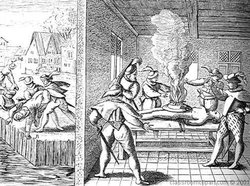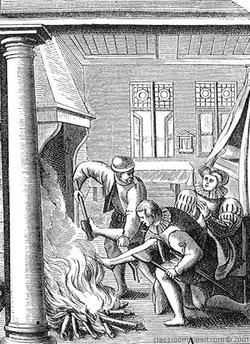Medieval Inquisition
|
|
- See also inquisition for other inquisitions and time periods.
The Medieval Inquisition started around 1184. It was in response to large popular heretical movements throughout Europe, in particular Catharism and Waldensians in southern France and northern Italy.
| Contents |
Origins
The medieval inquisitions were in response to growing mass heretical movements, in particular the Cathars first noted in the 1140s and the Waldensians starting around 1170. Heretical individuals, for example Peter of Bruis, had always been a challenge for the Church. However, the Cathars were the first mass heretical organization that posed a serious threat to both the authority of the Church and the accepted teachings of Christianity. To counter the threat of heresy the church used the weapon of inquisition.
History
All medieval inquisitions were decentralized. Authority rested with local officials based on guidelines from the Pope, but there was no central top-down authority running the inquisitions, as would be the case in post-medieval inquisitions. Thus there were different types of inquisitions in medieval Europe, the episcopal inquisition and the papal inquisition, distinguished by their administration and methods.
The first medieval inquisition, the episcopal inquisition, was established in the year 1184 by a papal bull entitled "Ad abolendam," "For the purpose of doing away with." The inquisition was in response to the growing Catharist heresy in southern France. It is called "episcopal" because it was administered by local bishops, which in Latin is episcopus. The episcopal inquisition was not very effective for many reasons. The bishops often did not reside in their dioceses, living in far-off cities such as Rome and rarely if ever visiting. When they did visit, bishops were busy and had many other responsibilities. Also, the procedures used in this inquisition were not effective. For example, according to the Ad abolendam, it was required to reveal the name of the accuser to the accused, and this would often lead to the revenge killing of the accuser before the trial.
In the 1230s the Church responded to the failures of the episcopal inquisition with a series of papal bulls which became the papal inquisition. The papal inquisition was staffed by professionals, trained specifically for the job. Individuals were chosen from different orders and secular clergy, but primarily they came from the Dominican Order. The Dominicans were favoured for their history of anti-heresy, education, and skill in debate. As mendicants, they were accustomed to travel and not interested in personal gain. Unlike the haphazard episcopal methods, the papal inquisition was thorough and systematic, keeping detailed records. Some of the most useful medieval documents from the Middle Ages involving first-person speech by medieval peasants come from papal inquisition records.
Inquisition procedure
The papal inquisition developed a number of procedures to discover and prosecute heretics.
Investigation
When a papal inquisition arrived at a town it had a set of procedures and rules to identify likely heretics. First, the townspeople would be gathered in a public place. Although attendance was voluntary, those who failed to show would automatically be suspect, so most would come. The inquisitors would provide an opportunity for anyone to step forward and denounce themselves in exchange for easy punishment. As part of this bargain they would need to inform on other heretics. In addition, the inquisitors could simply force people to be interrogated. Once information had been gathered, an inquisitorial trial could begin.
Trial
The inquisitorial trial generally favored the prosecution (the Church). The defendant would be allowed a lawyer, but if the defendant was convicted, the lawyer would lose his ability to practice. Therefore most lawyers never took the chance of defending a potential heretic. The trials were conducted in secret with only the inquisitors, the defendant and some inquisitorial staff to take notes. Inquisitors sequestered all of the property of the defendant. The defendant was not told the charges, but was always invited to confess, only guessing what for. The accused was expected to self-incriminate and did not have the right to face and question the accuser. It was acceptable to take testimony from criminals, persons of bad reputation, excommunicated people, and convicted heretics. Blood relationship did not exempt one from the duty to testify against the accused. Sentences could not be appealed once made. The inquisitor could keep a defendant in prison for years before the trial to obtain new information.
Despite the seeming unfairness of the procedures, the inquisitors did provide rights to the defendant. At the beginning of the trial, defendants were invited to name those who had "mortal hatred" against them. If the accusers were among those named, the defendant was set free and the charges dismissed; the accusers would face life imprisonment. This option was meant to keep the inquisition from becoming involved in local grudges. A confession under torture was not admissible in court, although the inquisitor could threaten the accused with torture during the proceedings.
Torture
Torture was used after 1252. On May 15, Pope Innocent IV issued a papal bull entitled ad extirpanda, which authorized the use of torture by inquisitors. It was a common part of the medieval judicial system and not particular to the inquisition. The torture methods used by inquisitors were mild compared to secular courts, as they were forbidden to use methods that resulted in bloodshed, mutilation or death. One of the most common forms of medieval inquisition torture was known as strappado. The hands were bound behind the back with a rope, and the accused was suspended this way, dislocating the joints painfully in both arms. Weights could be added to the legs dislocating those joints as well.
Punishment
Once the trial was concluded the results might take years to be revealed, during which time the defendant stayed in prison. The inquisitors would save up the cases and announce them at once in a public ceremony called, in Latin, sermo generalis, or "general sermon". Punishment could range from a long pilgrimage for first offenders, wearing a yellow cross for life, confiscation of property, banishment, public recantation, or long-term imprisonment, a method of punishment the inquisition pioneered that is still in use today. Burning at the stake was only for the most serious cases, including repeat offenders and unrepentant heretics. Execution was done not by the Church, which was forbidden to kill, but by secular officials. Life imprisonment or death was always accompanied by the confiscation of all the accused's property.
The inquisitors generally preferred not to hand over heretics to the secular arm for execution if they could persuade the heretic to repent. It was in the inquisitors' interest to be perceived as merciful, and they generally preferred to keep defendants alive in hopes of obtaining confessions. For example, Bernard Gui, a famous inquisitor working in the area of Toulouse (in modern France), executed 42 people out of over 700 guilty verdicts in fifteen years of office. Execution was to admit defeat, that the Church was unable to save a soul from heresy, which was the goal of the inquisition.
Legacy
The inquisitions in combination with the Albigensian Crusade were fairly successful in eliminating mass heresy. When they started, the heretical sects were quite strong and growing, but by 1300 the Waldensians had been driven underground and Catharism had largely been eliminated.


